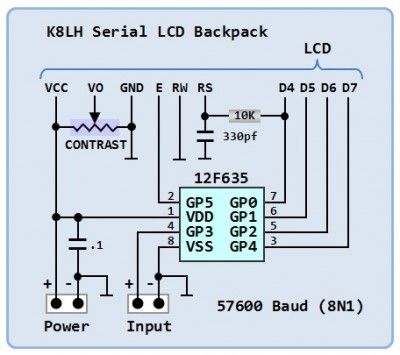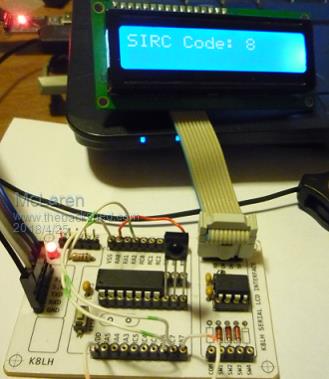
|

|
Forum Index : Microcontroller and PC projects : 1 wire LCD
| Author | Message | ||||
| vasi Guru Joined: 23/03/2007 Location: RomaniaPosts: 1697 |
As I was porting (from C AVR) a better one_wire library than Jallib actually has (the current one offers basic functionality, unable to sense all the changes on the bus) and, because I recently tested an 2x16 LCD in 4bit mode, I thought that maybe there is one_wire LCD library somewhere on the net. It is fantastic what I found if it will work: @McLaren (Mike) from DangerousPrototypes.com came with one 8pin microcontroller as one wire driver for an LCD. In fact, it had nothing to do with the one_wire protocol, it was just "physically identical". 
On the forum's thread you can download the sources. I know that there are also solutions based on shift registers but this one is very nice. Hobbit name: Togo Toadfoot of Frogmorton Elvish name: Mablung Miriel Beyound Arduino Lang |
||||
| viscomjim Guru Joined: 08/01/2014 Location: United StatesPosts: 925 |
Vasi, Just checked that one out. VERY COOL! I might give that a whirl just for fun. From a quick read, it seems that it uses a serial port? Will have to dig deeper. Thanks! |
||||
| vasi Guru Joined: 23/03/2007 Location: RomaniaPosts: 1697 |
The TX pin from your microcontroller must be hook up to the GP3 pin of PIC12F635 and the comm. speed seems to be 57600 bps! Yes, serial, but still one pin  . . Hobbit name: Togo Toadfoot of Frogmorton Elvish name: Mablung Miriel Beyound Arduino Lang |
||||
| Goeytex Regular Member Joined: 12/05/2014 Location: United StatesPosts: 74 |
Looks like a better option than the cheap I2C Backpacks via Ebay. I can live with 57600 bps. The Diagram shows a PIC12F635, however the code supplied on the link is for PIC12F683. But probably not too hard to port to PIC12F635. I happen to have several spare PIC12F683s (Picaxe 08M), so I will "re-purpose" one of these and see how it works out. Bill |
||||
| vasi Guru Joined: 23/03/2007 Location: RomaniaPosts: 1697 |
I looked at datasheet and both have a maximum of 8MHz internal oscillator so, there will be no problems regarding the comm.speed and other timings. 12F683 is better than so it should work from the first try. Hobbit name: Togo Toadfoot of Frogmorton Elvish name: Mablung Miriel Beyound Arduino Lang |
||||
| Goeytex Regular Member Joined: 12/05/2014 Location: United StatesPosts: 74 |
Qualified success. Upon initialization the display showed several characters of garbage. But accepts characters. It displays "Hello" after the garbage. It will not accept command data. The scope showed RS not staying high long enough. So the CAP was changed to 1nf and it seems to work OK now. By looking at the scope, it seems that the cap is being charged by two 5us pulses. With a 330p Cap there is a dip to zero in the middle of the signal on RS. Increasing the cap to 1nF reduces the dip to an acceptable level. Now there is no garbage, & I can send 0xFE, 0x01 to clear the screen. This is a Newhaven display with a ST7066U Controller. Could it be that the loading on the RS pin varies between driver chips? Looks very good, but needs some further testing before I'd say all is well. Bill |
||||
| vasi Guru Joined: 23/03/2007 Location: RomaniaPosts: 1697 |
Hi Bill, Thank you for your qualified testings. Yes, I have three 2x16 LCDs which required different timings for initialization. Exactly your controller!!!. So for me is great to know this (I will include the both capacitors and select them with a jumper). BTW, using ATmegas with a general LCD library it worked from the first try (it seems that they included all the necessary timings for all the LCD controllers). Thanks! datasheet Hobbit name: Togo Toadfoot of Frogmorton Elvish name: Mablung Miriel Beyound Arduino Lang |
||||
| Goeytex Regular Member Joined: 12/05/2014 Location: United StatesPosts: 74 |
Hi Vasi, So far so good. The little serial back pack is working great with a Picaxe 20X2 using Hardware serial (HSEROUT) at 57600 bps. This should work on any Picaxe that supports "HSEROUT". With a Picaxe using software "serout", the source code will need to be changed for 19200 bps and the Picaxe must set to operate at either 16 or 32 Mhz. This frees up 5 pins (vs 4-bit parallel) and even allows the 08M2 to control an LCD at relatively high speeds using only 1 pin. Should work fine on all other platforms as well. I may try to port the source code to a 14-Pin PIC to allow jumper selection of the baud rate and command control of the back light. But that's another day. Thanks for posting the link and bringing this to our attention. Bill |
||||
jman Guru Joined: 12/06/2011 Location: New ZealandPosts: 711 |
Hi SparkFun have a great serial one wire LCD backpack SparkFun Serial LCD It is based on a PIC 16F88 (I used a DIP version) Backlight is controlled via software (Nice) I have hand built a few of these and they work great with the Mite family It will run on 3.3v and 5V Source code is available and a precompiled hex There are two versions one for 2 Line LCD's and one for 4 Line LCD's I have attached the relevant files including the user manual 2014-05-24_000704_serlcd-v2_7_4line_10MHz.zip 2014-05-24_000716_serlcd-v2_7_2line_10MHz.zip 2014-05-24_000748_LCD_BackPack.zip Regards Jman |
||||
MicroBlocks Guru Joined: 12/05/2012 Location: ThailandPosts: 2209 |
@Goeytex, Don't forget about MOBI's I2C version that works on a small pic. No need to reinvent it again. And it includes a PWM controlled backlight. :) Microblocks. Build with logic. |
||||
| Goeytex Regular Member Joined: 12/05/2014 Location: United StatesPosts: 74 |
Lots of choices for those with the capability to flash a PIC. Even more if you can write / modify Assembly or C. The Spark Fun serial Backpack looks good, but $16.95 seems quite pricy for a serial backpack when the LDC module itself only costs from $2 to $12 depending upon the source. I don't particularly like that the micro uses a crystal or that the code was written in CC5X. Shift register based I2C backpacks/LCDs are cheap but generally have poor performance and tend to be buggy ( Especially the $2 - 3$ ones that are Asian sourced) I once did a backpack based upon the Picaxe AXE133 FIRMWARE. It uses a Picaxe 18M2. Works good, but can barely get out of it's own way with a fixed baud rate of 2400. The firmware is interpreted Picaxe BASIC, but could likely be ported to another Basic & compiled which would allow it to operate to operate at much higher speeds. The code is actually very tight, it's just that using software serial and being interpreted limits performance. |
||||
| vasi Guru Joined: 23/03/2007 Location: RomaniaPosts: 1697 |
TZA, I have available a couple of dip 12F629, smd 12F675, one 12F683, a 16f628A and a 16F690. There is a dedicated chip, DS2408 for one_wire buses but for me, the 12F683 solution is better, cheaper and simpler to build (no one have some admiration for what someone was able to do with a little 8pin micro?). Probably will be the same for many. We have in JALLIB repository a serial LCD based on 16F88: sources, schematic, pcb. And having the code, I can easily adapt it for 16F690 or any suitable micro anytime but it wasn't what I looked for. In JALv2 + Jallib is trivial to change the microcontroller of a project. Hobbit name: Togo Toadfoot of Frogmorton Elvish name: Mablung Miriel Beyound Arduino Lang |
||||
| McLaren Newbie Joined: 28/06/2011 Location: United StatesPosts: 11 |
Hi guys. Just came across this thread and wanted to say thank you for trying out the little 8-pin Serial backpack. Cheerful regards, Mike Mike McLaren, K8LH |
||||
| McLaren Newbie Joined: 28/06/2011 Location: United StatesPosts: 11 |
I'd love to see pictures of how you guys implemented this little backpack design. I didn't do much with it except to put it on a little 8-14-20 pin development board (picture below). Cheerful regards, Mike McLaren, K8LH (Michigan, USA)  Mike McLaren, K8LH |
||||
| The Back Shed's forum code is written, and hosted, in Australia. | © JAQ Software 2025 |